From the imposing mosque-cathedral to colorful patios bursting with flowers, there are so many wonderful things to do in Córdoba, Spain! This guide shares the must-see attractions in Córdoba, plus answers FAQs about planning a visit.
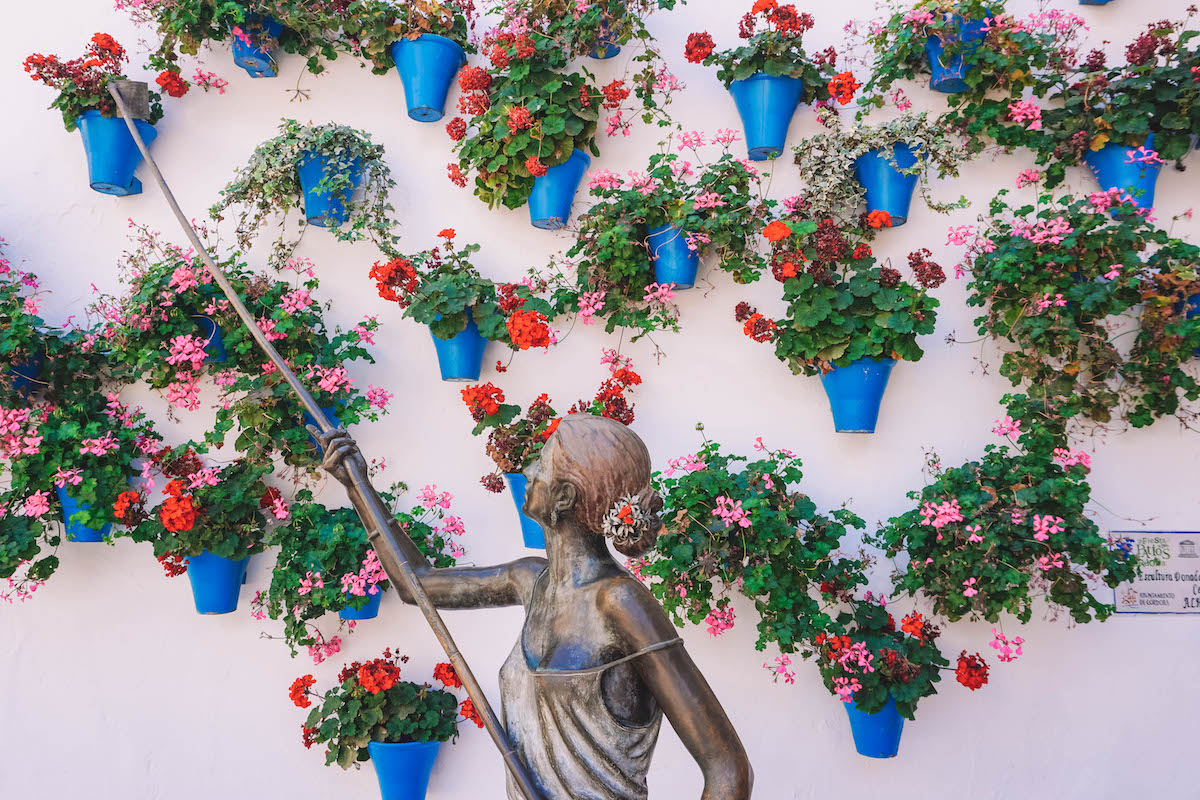
Formerly the capital of Islamic Spain, Córdoba was once the largest and most advanced city in all of Europe. This beautiful city in Andalusia was a hub for astronomy, medicine, and philosophy under Muslim rule. After being captured by the Catholic monarchy in 1236, Córdoba was reincorporated into Christian Spain.
Today Córdoba is perhaps best known for its Mosque-Cathedral, “La Mezquita.” Although there are enough attractions in Córdoba to fill two days of adventuring, one full day will give you a good feel for the local culture and enough time to see the main sights.
Córdoba may not be as prominent as it once was, but its fascinating history and winding streets make it one of the best cities to visit in Andalusia. In this post, I’ll be sharing the best things to do in Córdoba, Spain as well as answering some FAQs about the city.
Whether you’re planning a day trip to Córdoba from Malaga or Seville, or are interested in spending more time in this historic city, this guide will help in the planning process!
Table of Contents
Map of the Top Attractions in Córdoba
Best Things to Do in Córdoba, Spain
Many of the top Córdoba tourist attractions can be found within La Juderia, the former Jewish Quarter or “Old Town” of the city. You can’t see everything mentioned in this post in a day, but you can see most of them!
Or, spread your wanderings between two full days in Córdoba to have a more relaxed visit. Either way, the city is very walkable — you need maybe 15 minutes to traverse the Old Town on foot, so take it easy!
1. Mosque-Cathedral of Córdoba
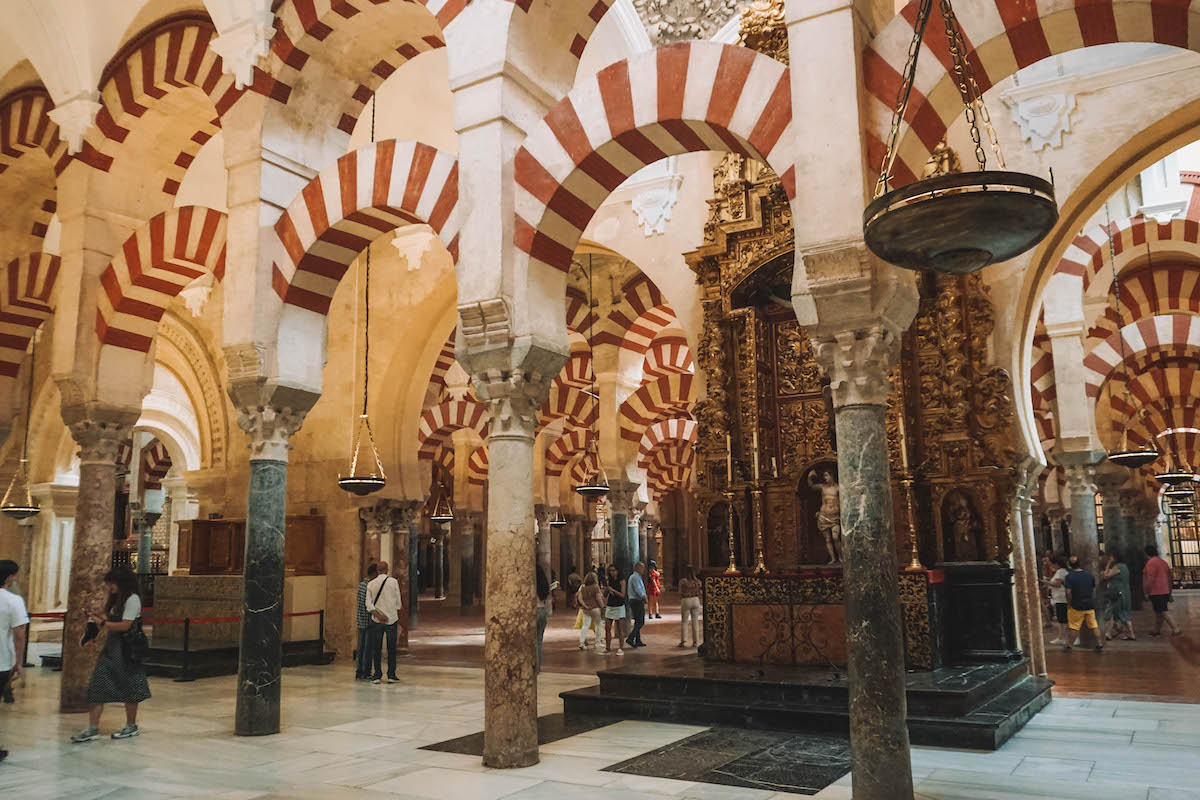
Time needed: 1 hour
The absolute top thing to do in Córdoba is visit the Mosque-Cathedral, or “La Mezquita.” It’s a former Islamic mosque that was converted into a Catholic cathedral in the 13th century.
The original mosque was built in the 8th century when Muslims ruled over much of Spain. The Reconquista or reconquest of Spain raged for over 700 years and revolved around the Muslims and Catholics both trying to retain control over the country.
The Muslim influence remains particularly apparent in the Andalusia region of Spain, where Córdoba lies. However, unlike other mosques-turned-cathedrals, the Mezquita of Córdoba retains its original mosque architecture. In most other cases, the mosques were either torn down and rebuilt as Catholic cathedrals or the mosques were so altered that only the most discerning eyes can spy the remnants of Islamic architecture amongst the Christian iconography.
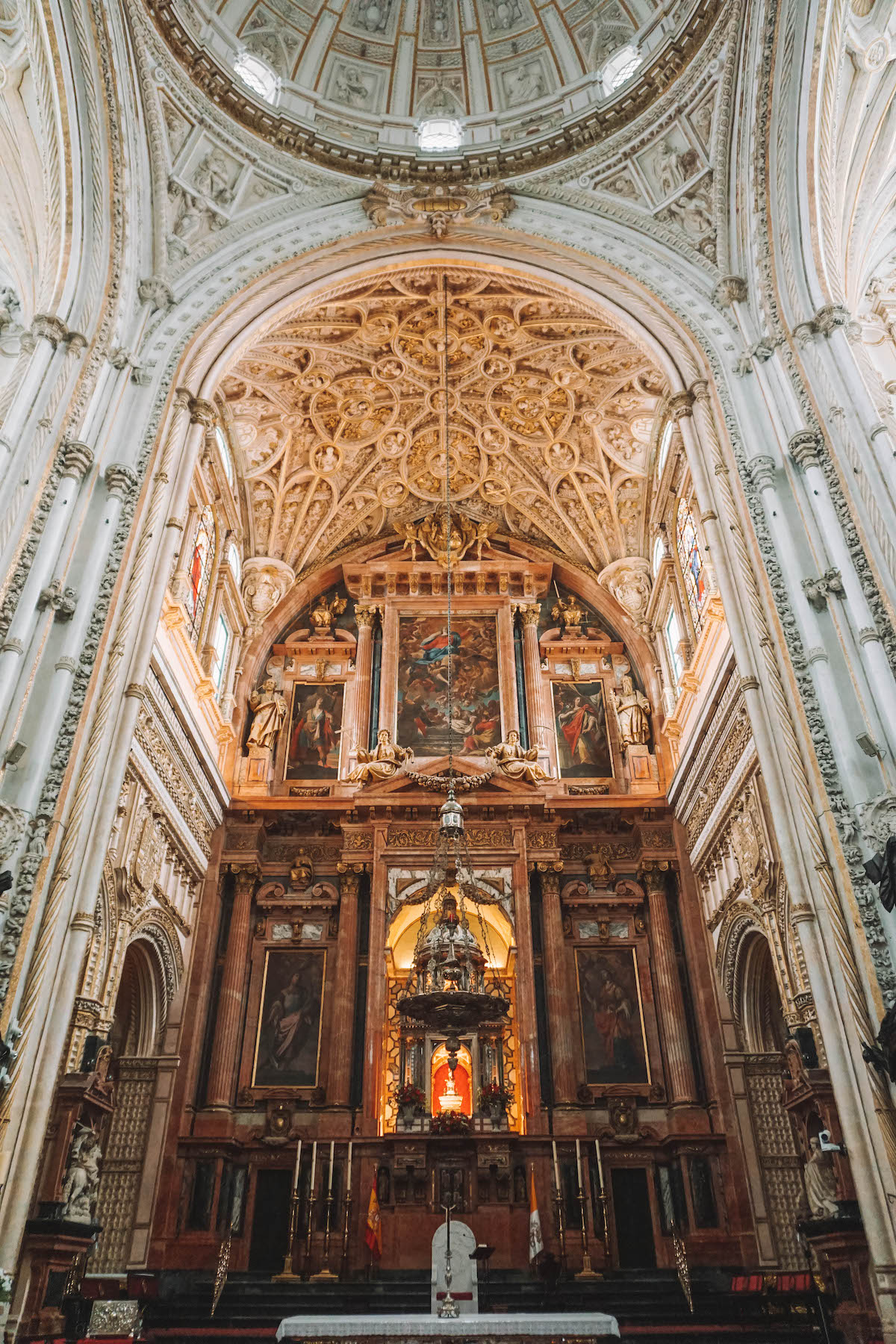
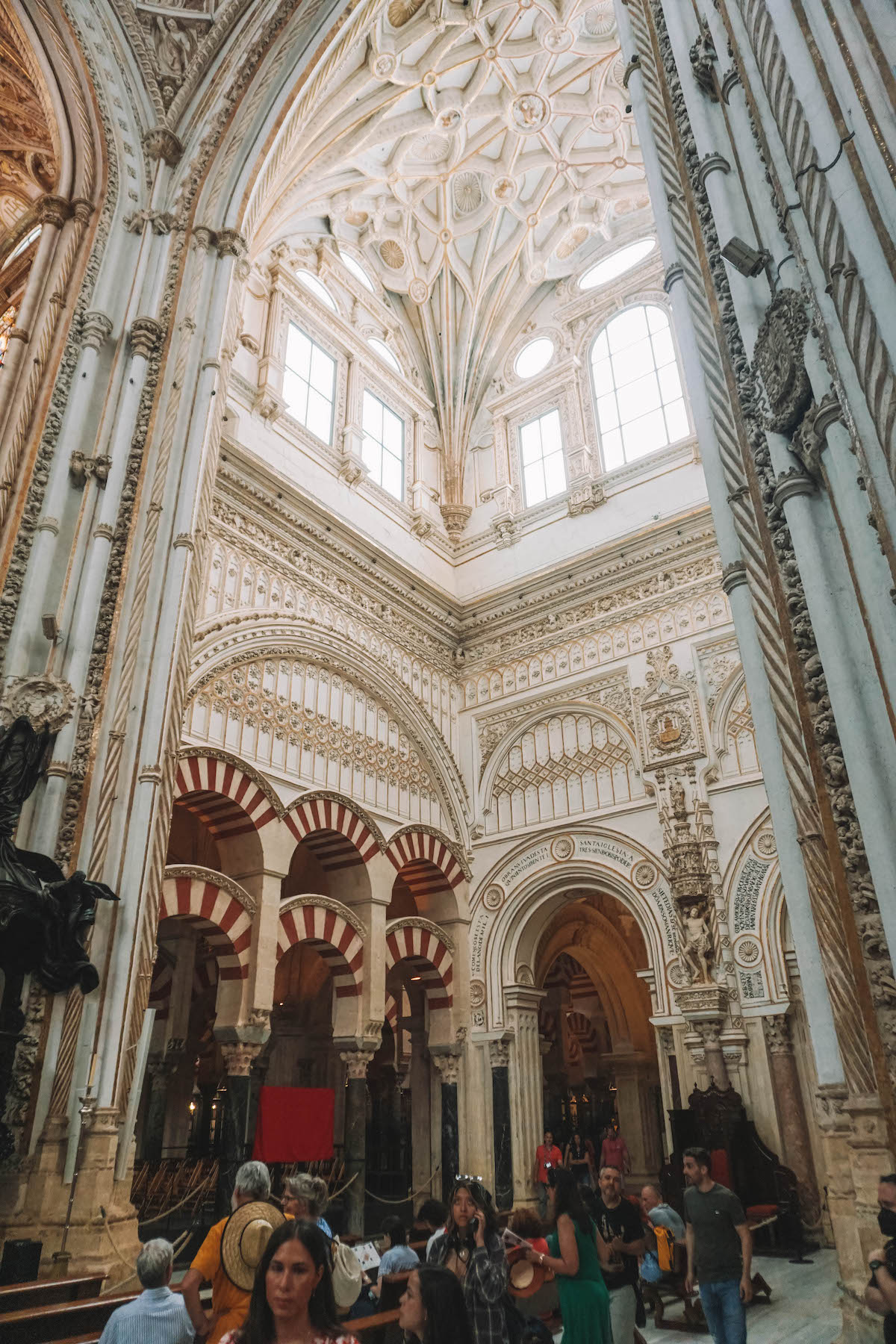
As such, the Mosque-Cathedral of Córdoba is truly unlike anyplace else you’ll see during your travels. Some 850 pillars divide the interior of the Mezquita.
In addition to the Islamic horseshoe arches throughout the building, there’s also a Catholic high altar and choir that were added in the 16th century. The original minaret has also been replaced with a bell tower.
The unique combination of architectural styles and religions that have converged to create the Mezquita as we know it today is why it’s one of the best places to visit in Córdoba, Spain. It doesn’t truly blend religions, though, because although it’s called the “Mosque-Cathedral” it’s strictly a Christian place of worship — Muslims are not allowed to pray within the cathedral.
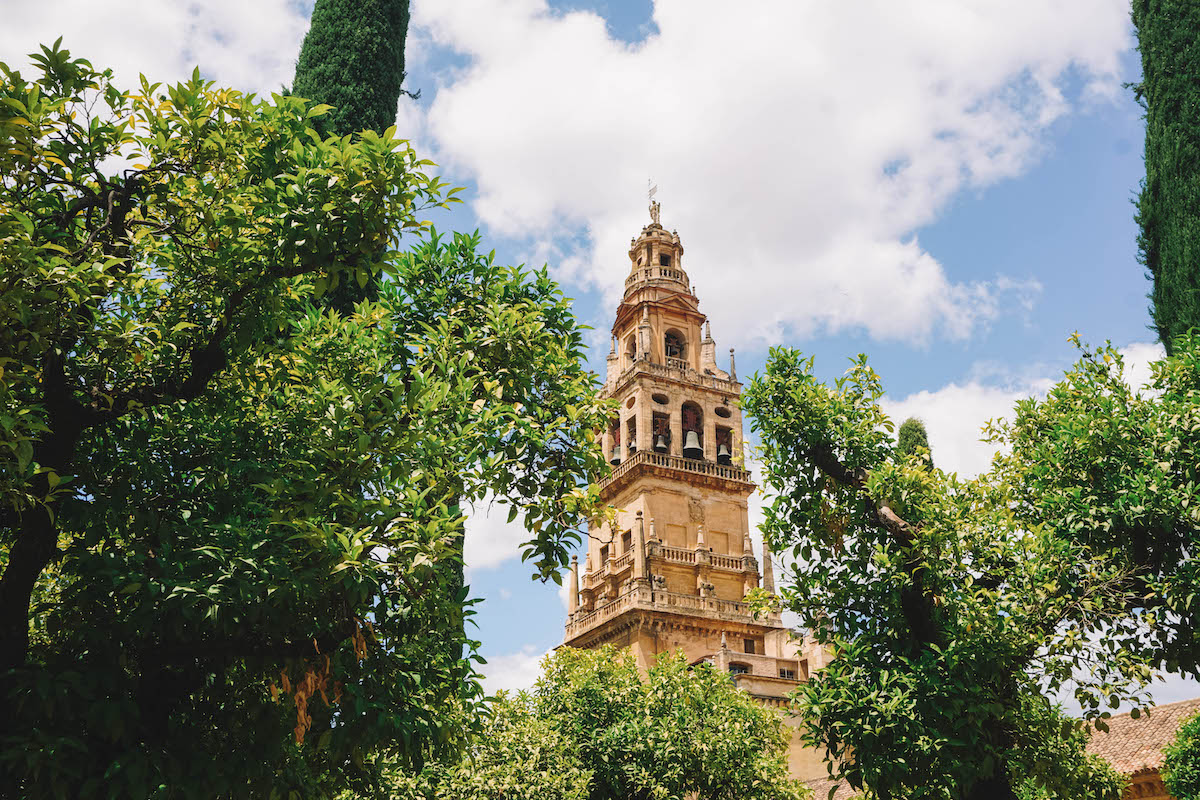
After touring the Mosque-Cathedral, head outside and rest under the shade of the orange trees within the Patio de los Naranjos (“Court of the Oranges”). This inner courtyard is where Muslims would have performed ablutions, or ritual cleansing, prior to entering the mosque. Now, dozens of orange trees have been planted in the courtyard, providing shade and perfuming the area with their delicate fragrance.
Be sure to look for the wooden beams hung on the wall of the far side of the courtyard. They’re the old roof beams that once held up the cathedral and date from the 10th century. The beams you see in the cathedral today are replicas, and because the cathedral is so dark inside it’s difficult to see their intricate carvings.
If desired, you can pay extra to climb the bell tower of the Mosque-Cathedral. I opted to save a few Euros by skipping this attraction in Córdoba, but if you want to see the city from above you may find it worth your time.
Tip: The Mezquita is free Monday through Saturday between 8:30 to 9:30am.
2. Palacio de Viana
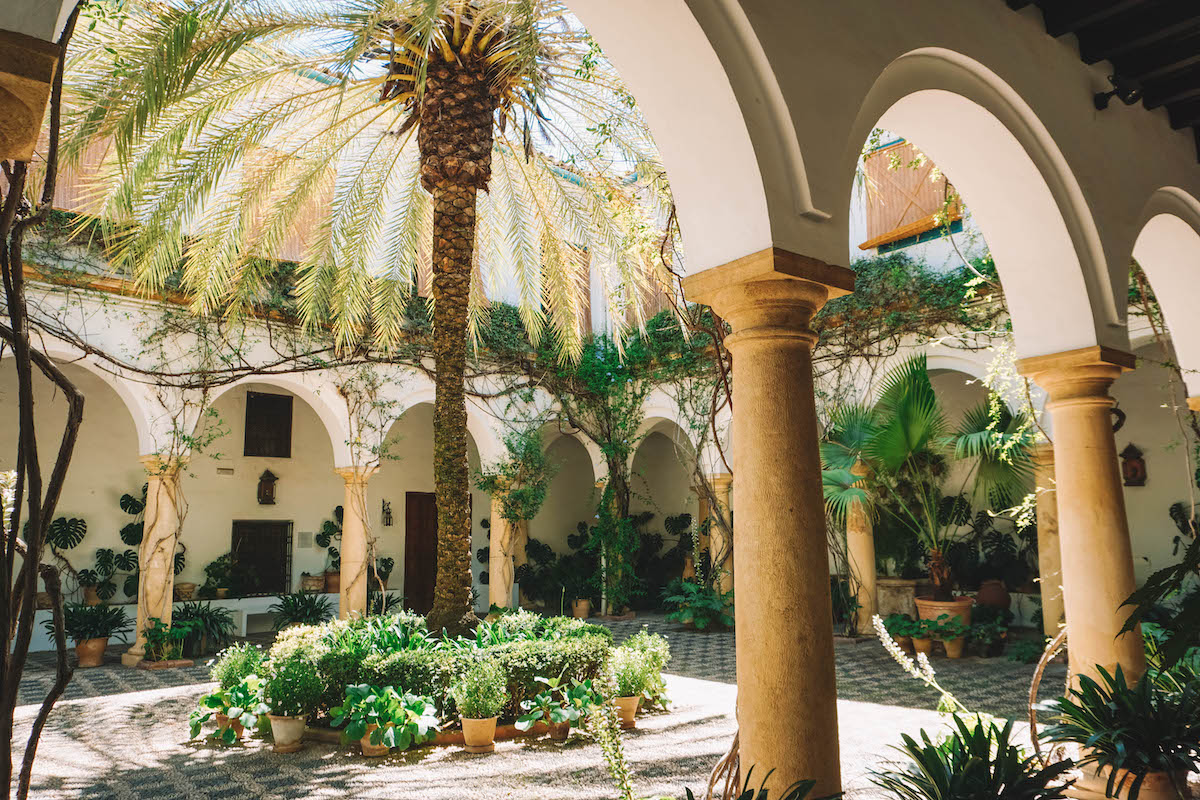
Time needed: 90 minutes
One of my personal favorite places to visit in Córdoba is Palacio de Viana (Viana Palace). Besides the Mezquita, Córdoba is best known for its patios, or courtyards. Córdoba’s patios are typically overflowing with brightly colored flower pots and brimming with plants — a true oasis within the city! However, the city’s patios are part of private residences and are therefore tucked away from prying eyes.
A Patio Festival takes place every May, but the best place to see patios in Córdoba the rest of the year is Palacio de Viana. It’s one of the best preserved stately homes in Córdoba and is known for its 12 stunning patios.
The palace was built in the 1400s and was inhabited until 1980. Throughout the years, it passed through the hands of 18 different owners and its network of patios grew over time. Each of the 12 patios has a unique layout and theme, and each is beautiful!
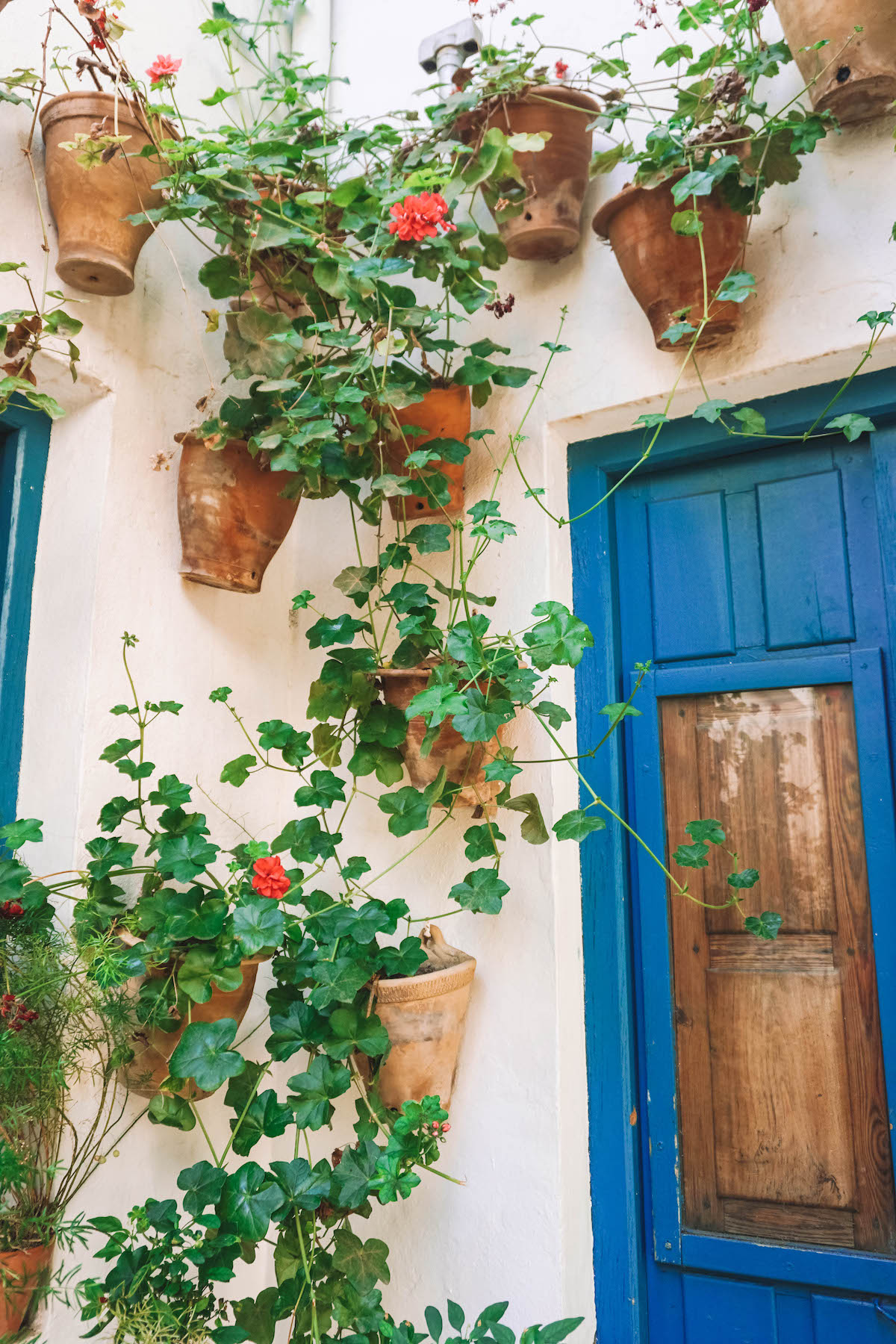
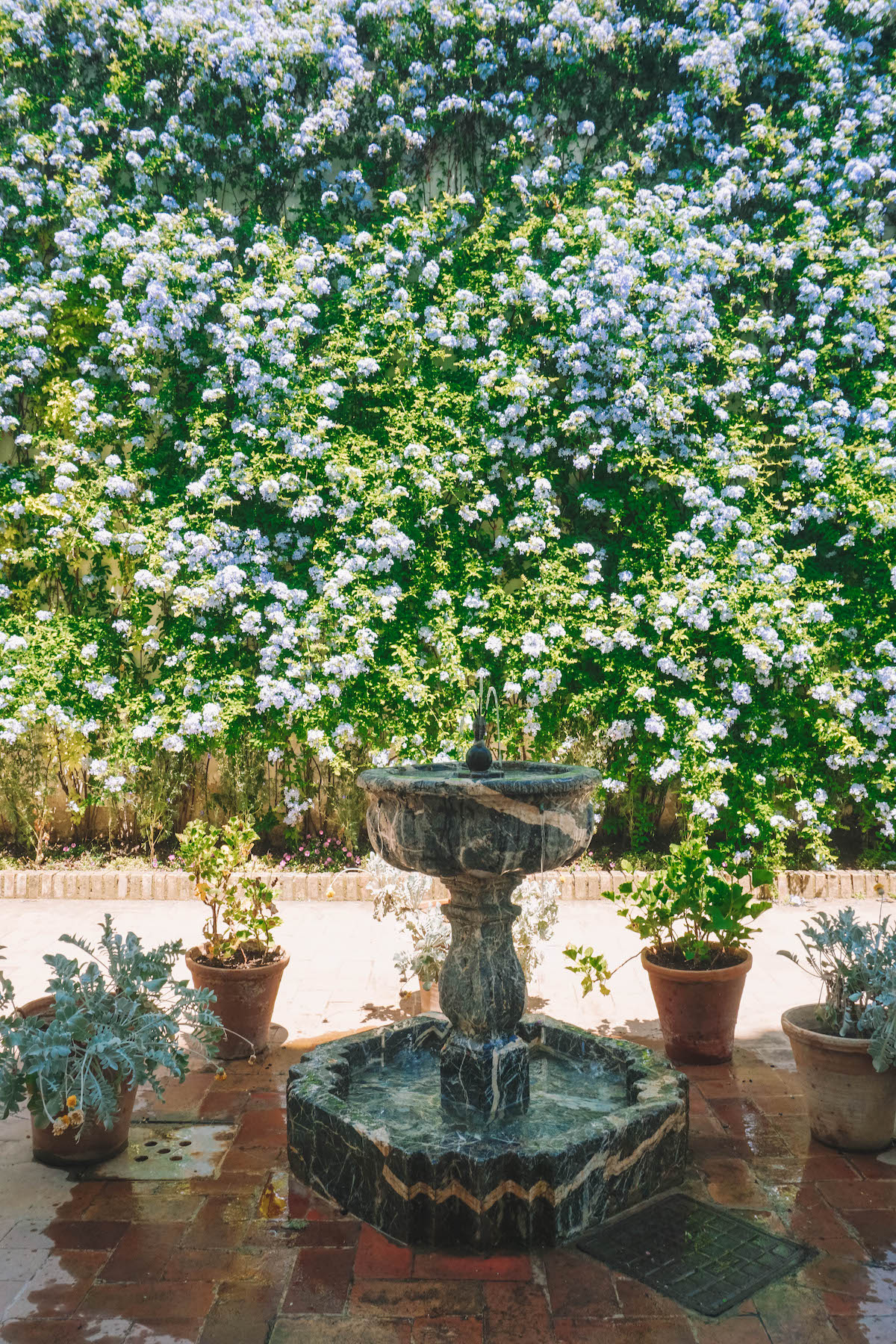
When visiting Palacio de Viana, you can pay to see just the patios or you can purchase a combination ticket that includes a guided tour of the palace. I love stately homes, but Palacio de Viana fell short for me. While the history of the place was interesting I wouldn’t recommend the guided tour to anyone who’s short on time or is trying to travel on a budget.
The patios, however, are absolutely one of the best sights in Córdoba! My favorites of the 12 patios at Palacio de Viana were:
- Patio de los Gatos — The oldest documented patio in the city with lots of brightly colored flower pots hung on a wall. Makes for a great photo! (Shown on the left in the photo collage above.)
- Patio del Pozo — A pretty little patio centered around a well.
- Patio de Recibo — The first patio you walk through. It was built to impress visitors (and it totally does!). Expect lots and lots of leafy greenery, with a jungle-like atmosphere.
3. Alcazar of the Christian Monarchs
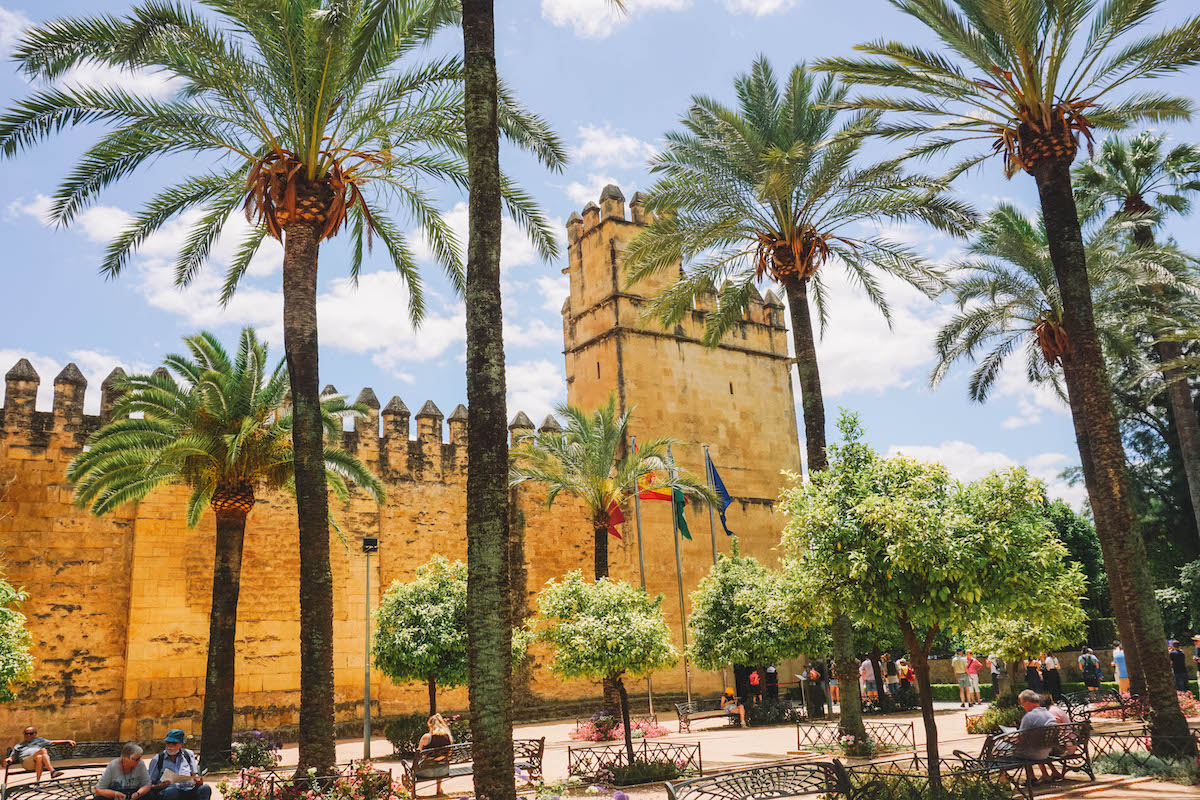
Time needed: 90 minutes
Another popular place to visit in Córdoba is the Alcazar of the Christian Monarchs (Alcázar de los Reyes Cristianos). This imposing fortress also served as a palace, and it’s where the Catholic monarchs Ferdinand and Isabella lived for eight years during the Reconquista. The Alcazar was also once home to the Spanish Inquisition, a garrison of Napoleon’s troops, and Christopher Columbus was briefly hosted here before his journey to the New World.
For all its fascinating history, I must admit that touring the actual building of the Alcazar was a bit of a let-down. The interior is mostly empty, with few furnishings and even fewer information points explaining the function of each room, the historical figures who came in and out of the Alcazar, and so forth.
The one major exception being the beautiful Hall of Mosaics, which houses a lovely array of ancient Roman mosaics that were unearthed in Córdoba!
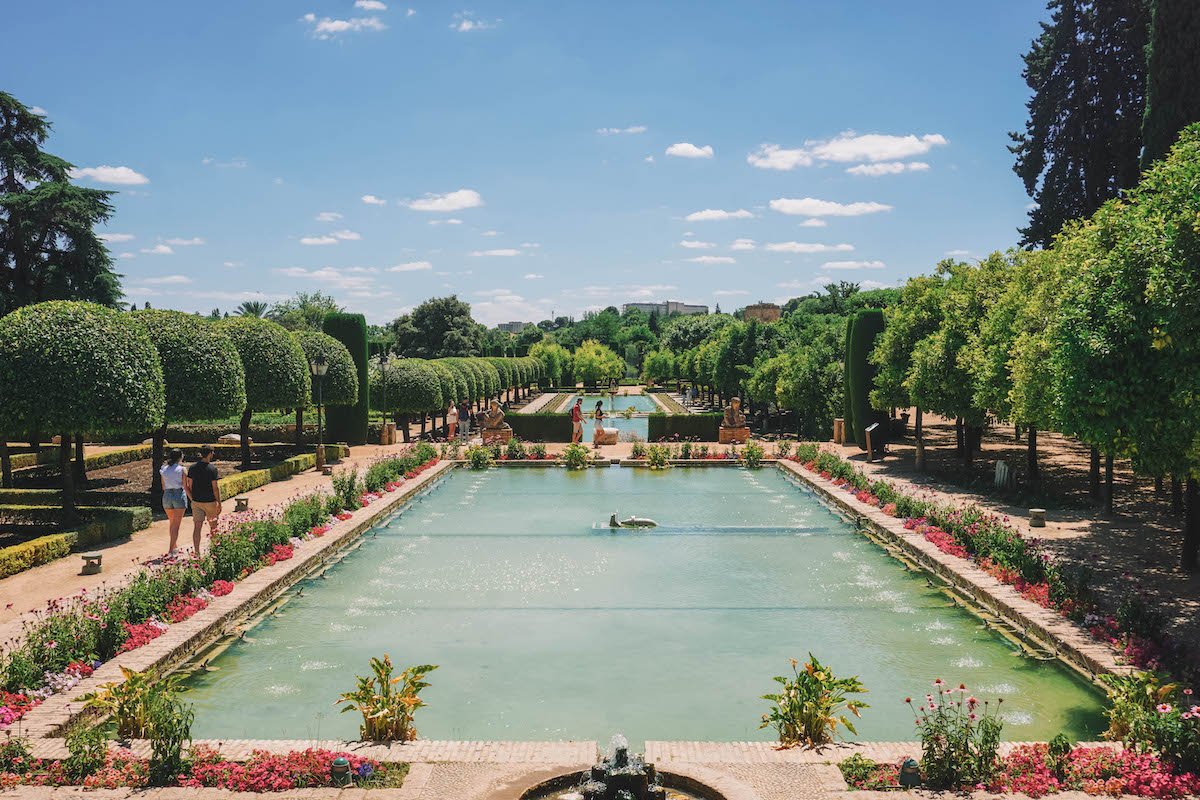
You may be wondering, Claire, if the Alcazar is such a letdown, why have you included in on your list of the top things to do in Córdoba, Spain? The gardens!
The gardens of the Alcazar are beautiful! They’re Mudejar-inspired, meaning they were designed under the Christian rule of Spain but were heavily influenced by Islamic culture. There are also two courtyards within the Alcazar, both of which are lovely.
The Alcazar is quite cheap to enter (5 Euros or so), so I recommend zooming through the building and spending most of your visit in the gardens. If you have extra time on your hands, bring a book and find a shady spot to read.
4. Calleja de las Flores (Flower Street)
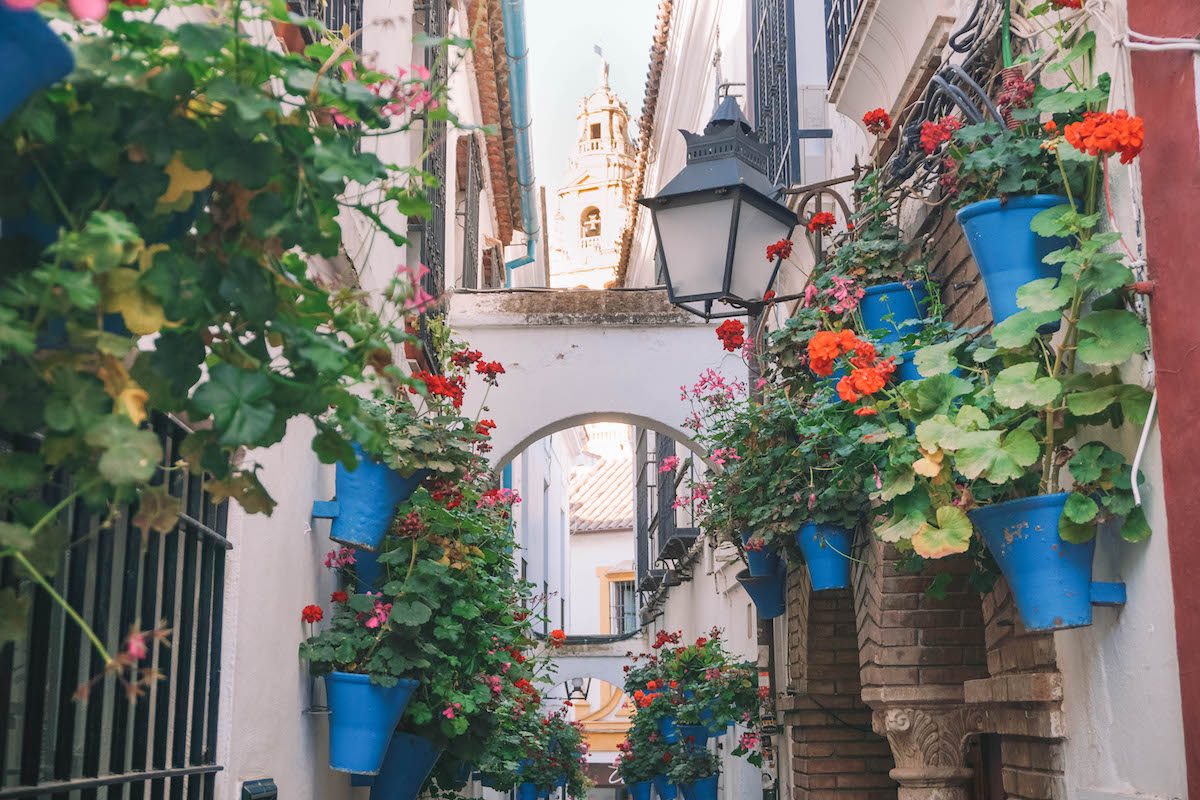
Time needed: 10 minutes
Near the Mosque-Cathedral of Córdoba you’ll find a quaint white-washed alleyway lined with bright blue flower pots — this is the Calleja de las Flores, or Flower Street. I’m not sure how this became one of the top Córdoba tourist attractions, but it’s very popular with visitors and becomes quite crowded by midmorning.
As such, I recommend visiting Flower Street first thing in the morning if you want an unobstructed view of the street with the cathedral’s bell tower rising in the background.
5. Roman Bridge
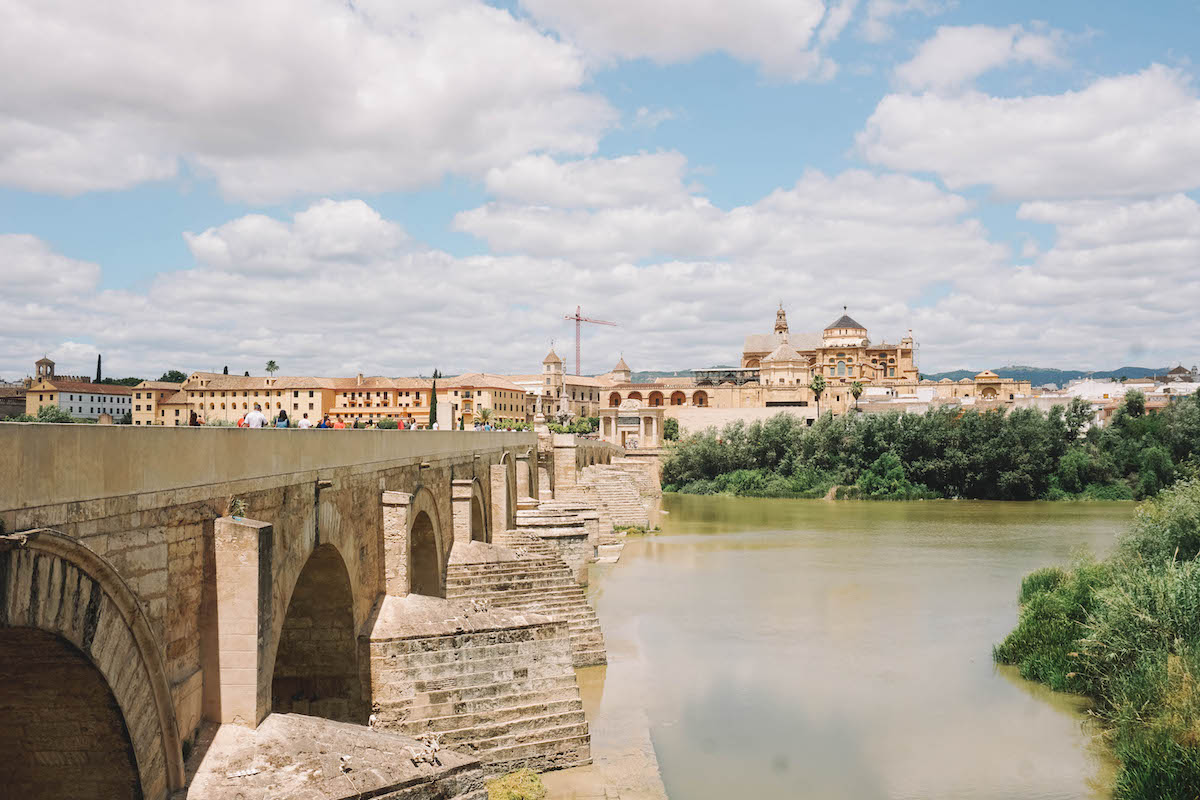
Time needed: 15 minutes
The Roman Bridge (Puente Romano) of Córdoba was first built in the 1st century by — you guessed it! — the Romans. The bridge has been rebuilt many times over the centuries, though, so the structure you see today isn’t the original. The bridge has 16 arches, which still rest on the Roman foundations.
You can access the bridge from the Old Town, just behind the Mosque-Cathedral. Walk across the bridge, away from the cathedral, for a nice view of the Old Town and surrounding areas. The view from the opposite riverbank is one of the best sights in Córdoba!
The area of the city across from the Roman Bridge is much more modern and there’s not much to do there from a tourist perspective. However, there are some excellent local restaurants on the opposite riverbank, and they’re a lot cheaper than anything you’ll find in the Old Town.
6. Calahorra Tower
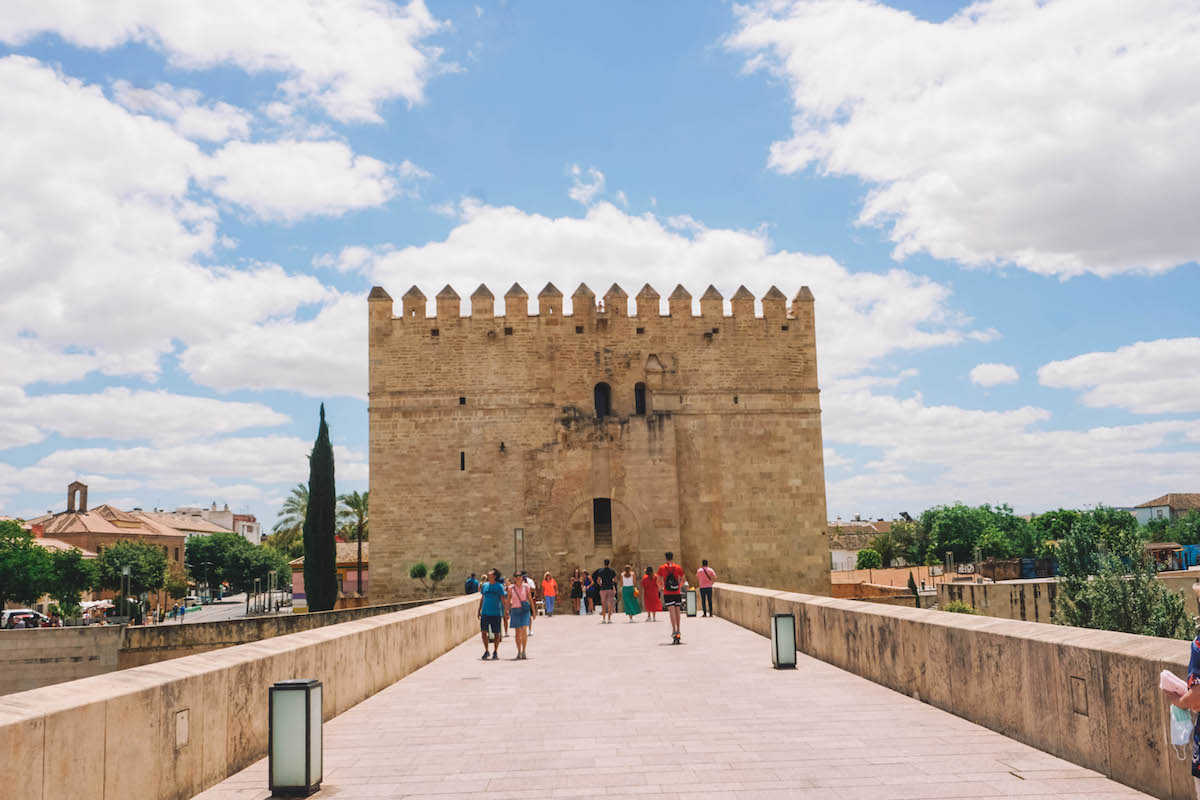
Time needed: 30 minutes
The Calahorra Tower (Torre de Calahorra) is a fortified gate along the Roman Bridge that now houses the Museo Vivo de Al-Andalus. The museum spans just eight small rooms, but the view from the top of the tower is great. If you already ascended the bell tower of the cathedral, going up the Calahorra Tower may not be worth it; but if you have the time and budget you may as well go up!
7. Almodóvar Gate
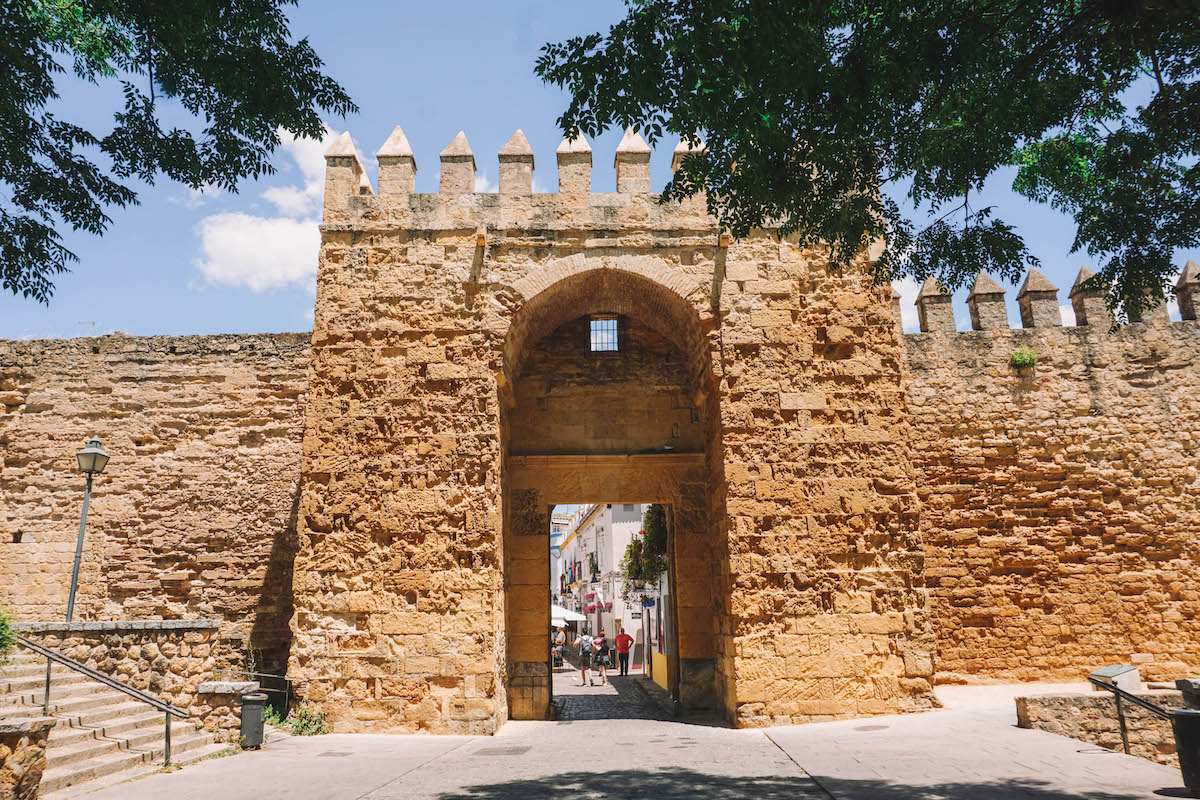
Time needed: 10 minutes
One of only three medieval city gates still standing in Córdoba, the Almodóvar Gate (Puerta de Almodóvar) is flanked by a parapet walk. You can’t access the parapet, but the gate makes for a great photo! It leads into La Juderia (the Jewish Quarter) with its winding, narrow streets.
8. Templo Romano
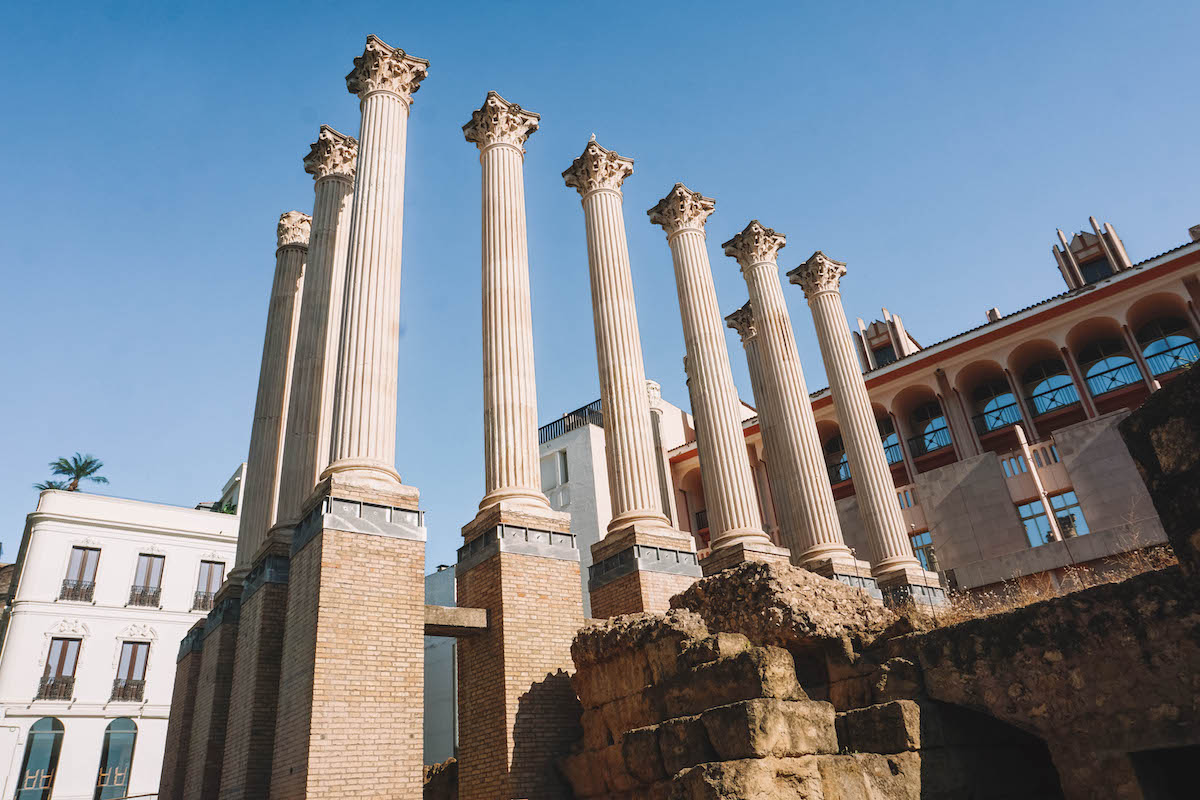
Time needed: 5 minutes
Before either the Muslims or Catholics ruled Spain, the Romans dominated the country. The Templo Romano lies in the middle of a busy street in Córdoba. Just 11 columns remain of this 1st century Roman temple that was once the largest in all of Córdoba. The temple is believed to have been dedicated to the emperor, hence the impressive size.
The temple ruins are free to look at from the sidewalk. Keep an eye out for the cats that call the temple home!
9. Plaza de la Corredera
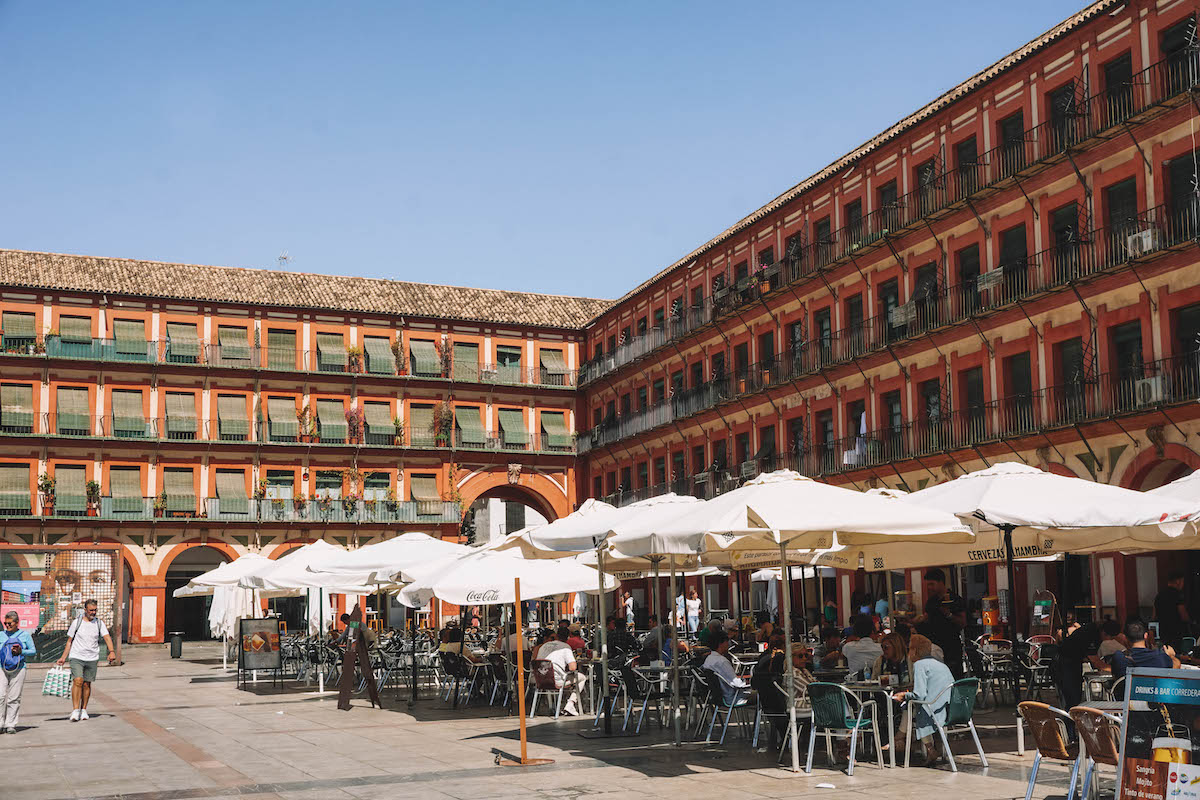
Time needed: 30+ minutes (if eating)
If you’re wondering what else to see in Córdoba, I encourage you to visit Plaza de la Corredera, preferably at night. It’s a perfectly rectangular square in the city center with arched porticoes running around the ground floor.
Plaza de la Corredera is primarily residential, with bars and cafes at street level. The plaza is fairly quiet throughout the day, but at night it’s a bustling spot for families and friends to meet and chat over a drink or two. My AirBNB was situated above the plaza and listening to the buzz of Spanish floating through my windows was the perfect way to fall asleep each night.
This is a great spot to come and relax once the sun has set. The drinks here are quite cheap and there’s no rush to give up your table.
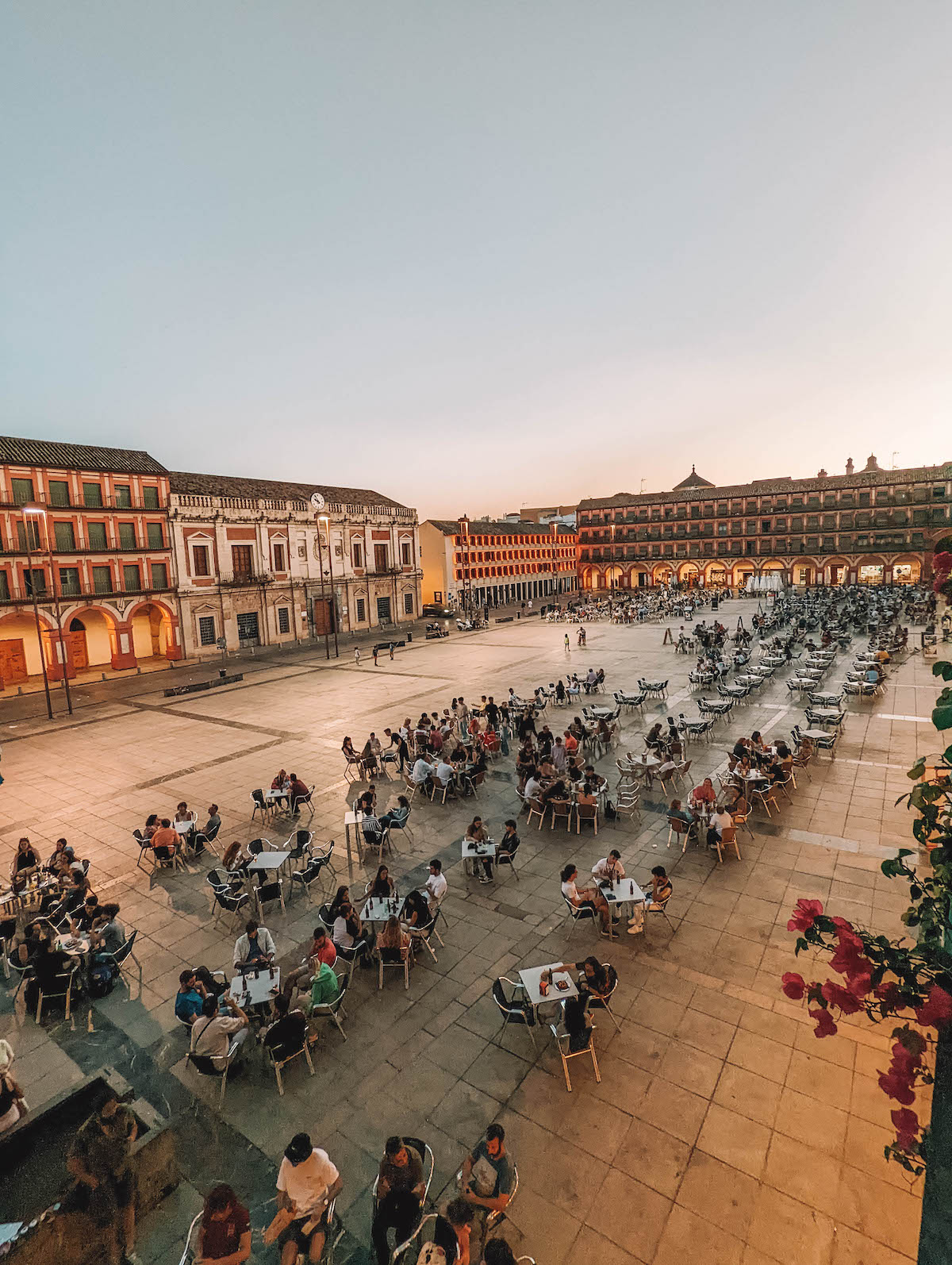
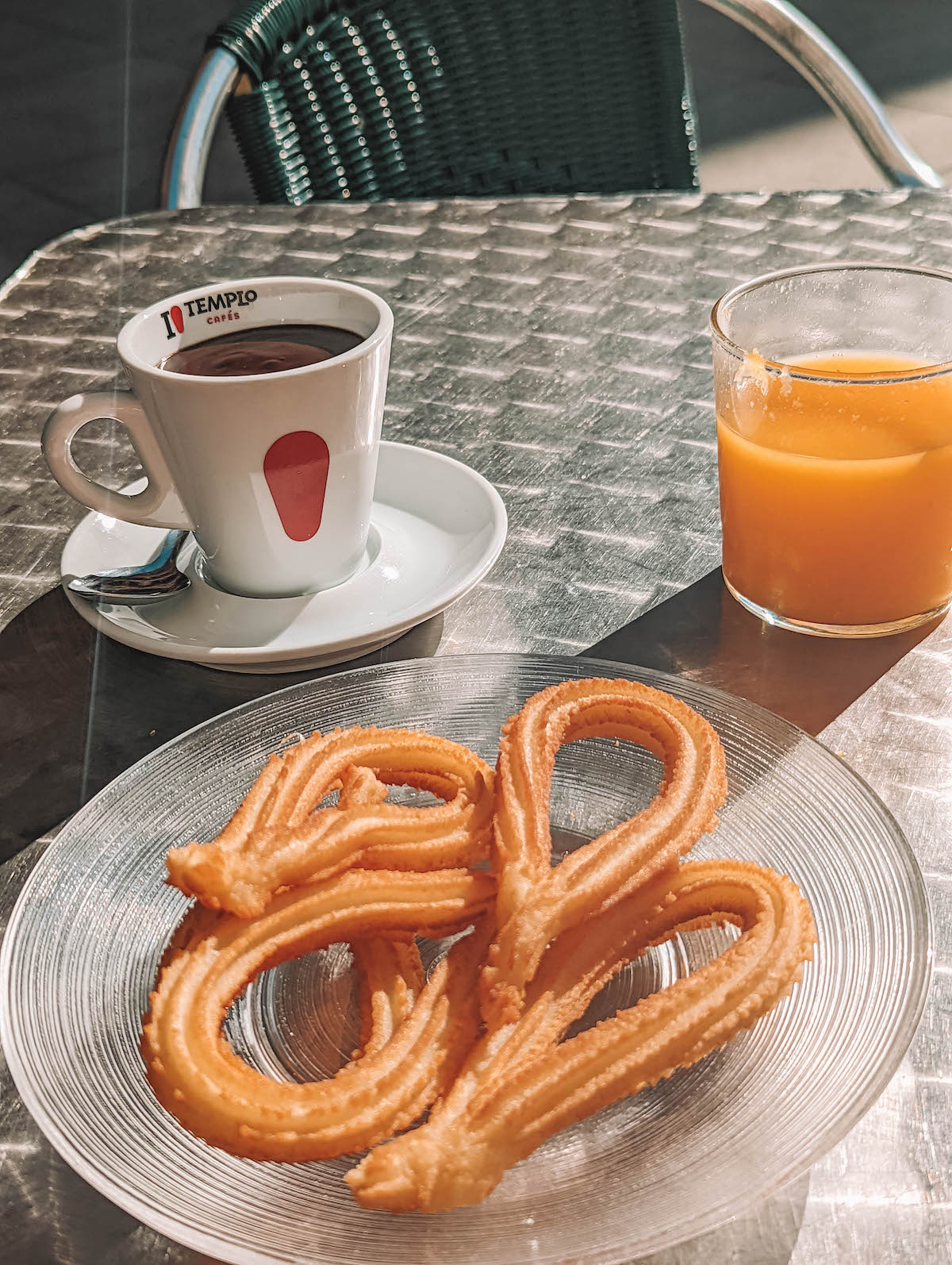
If you come to Plaza de la Corredera in the morning, be sure to grab churros con chocolate at Mari Paz. They were some of the best churros I had in Spain!
Plaza de la Corredera is also home to the Casa Del Corregidor de Córdoba. It was formerly the town hall and prison, which has since been transformed into a market. It’s a great place to get fresh produce if you’re in town for a night and want to cook something!
Tip: Roman mosaics were found at the Plaza de la Corredera during past construction work. Those mosaics are now on display in the Hall of Mosaics in the Alcazar of the Christian Monarchs!
10. Plaza de las Tendillas
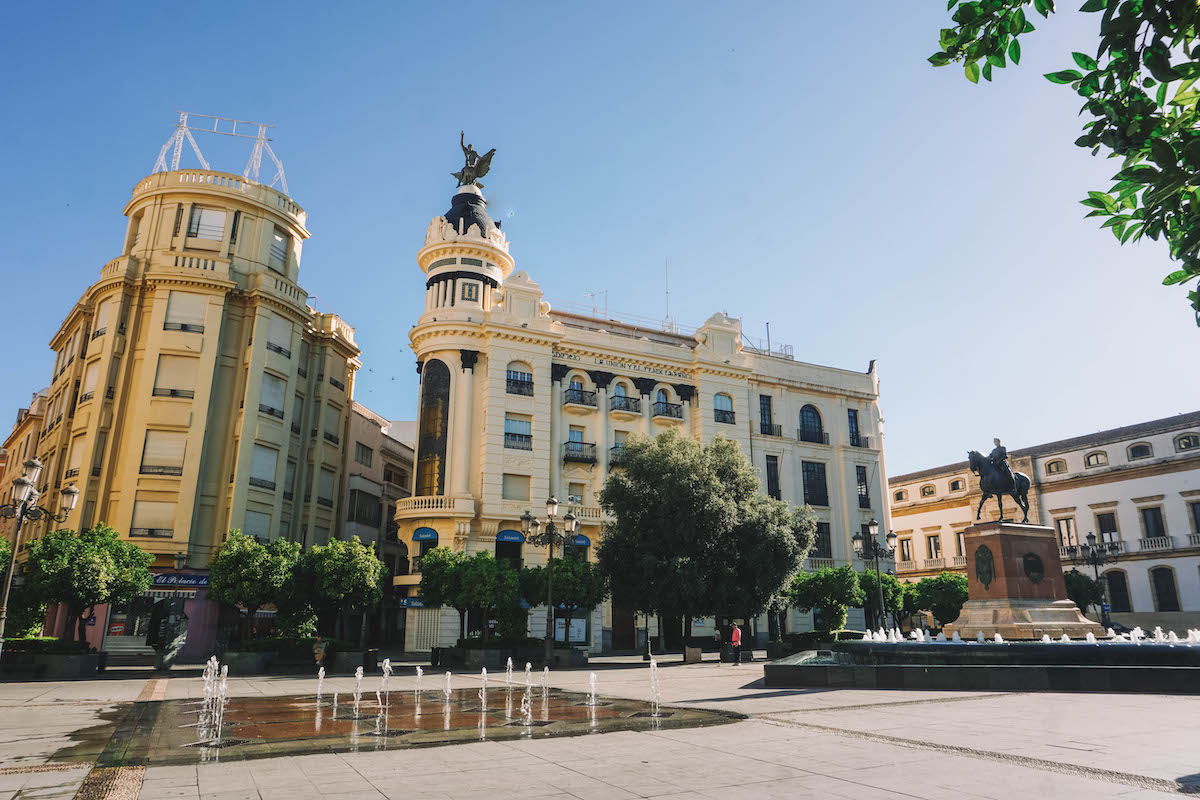
Time needed: 30+ minutes (if eating)
Another notable plaza in Córdoba is the Plaza de las Tendillas. This square connects the modern part of the city with the old and is a nice spot to hang out, grab a drink or bite to eat, and relax near the fountain.
There are also a few major shopping streets leading off the square, including: Calle Jesús Maria, Calle Conde de Gondomar, and Calle Cruz Conde.
11. Old Town
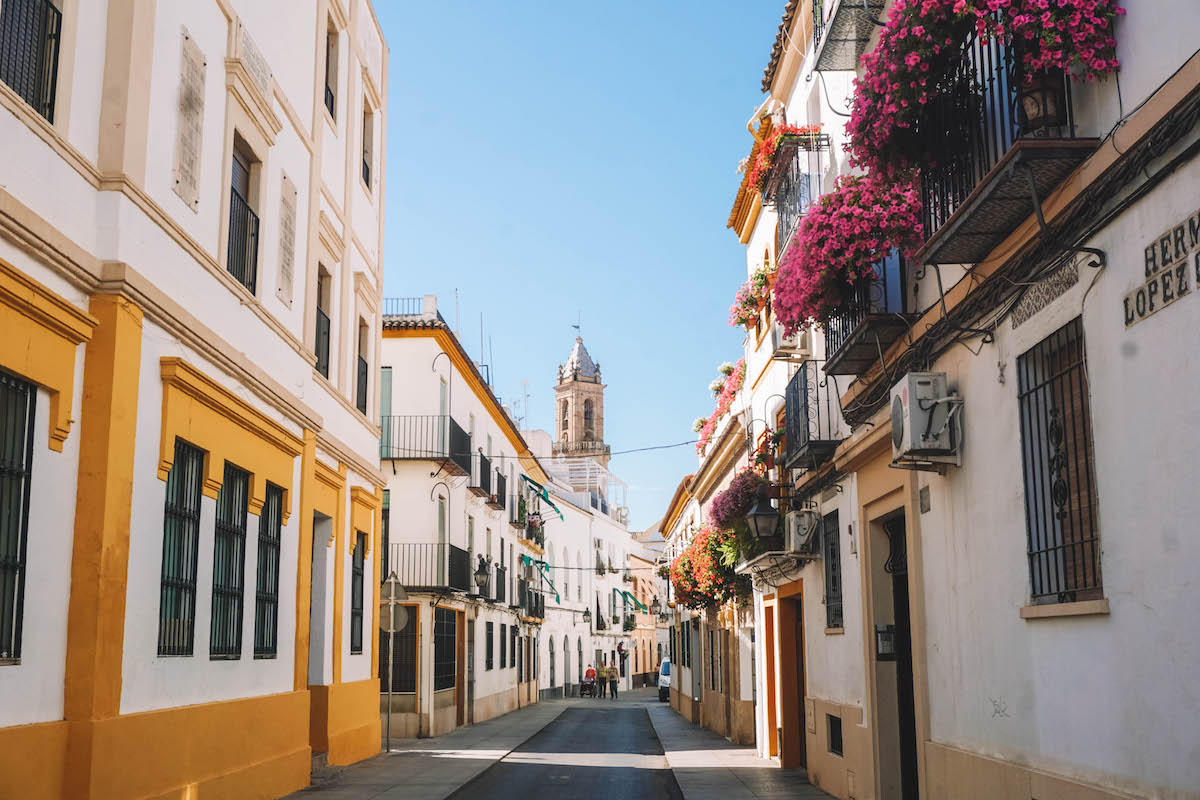
Time needed: As much time as you want!
Most of the Córdoba tourist attractions I’ve listed fall within the Old Town. Although Córdoba is a city, it’s incredibly compact and feels more like a town. The best way to visit the Old Town is on foot — there are so many cute streets to get lost in!
In addition to doing the activities listed in this post, I also recommend giving yourself some time to aimlessly explore the Old Town. It’s filled with local boutiques, cafes, and galleries and there’s lots to uncover. Just note that the areas closest to the Mosque-Cathedral will always be the busiest, so head further out to escape the crowds.
How Many Days Do You Need in Córdoba, Spain?

A day trip to Córdoba is perfect! Córdoba is easy to reach from Malaga or Seville and since the Old Town’s so compact you can easily see most of the top attractions in a single day.
With that being said, my trip to Córdoba lasted two days. I was on the road for two full weeks, so I appreciated having some down time to relax in Córdoba, but if you’re on a tight schedule then one day really is enough time.
Itinerary for 1 or 2 Days in Córdoba, Spain
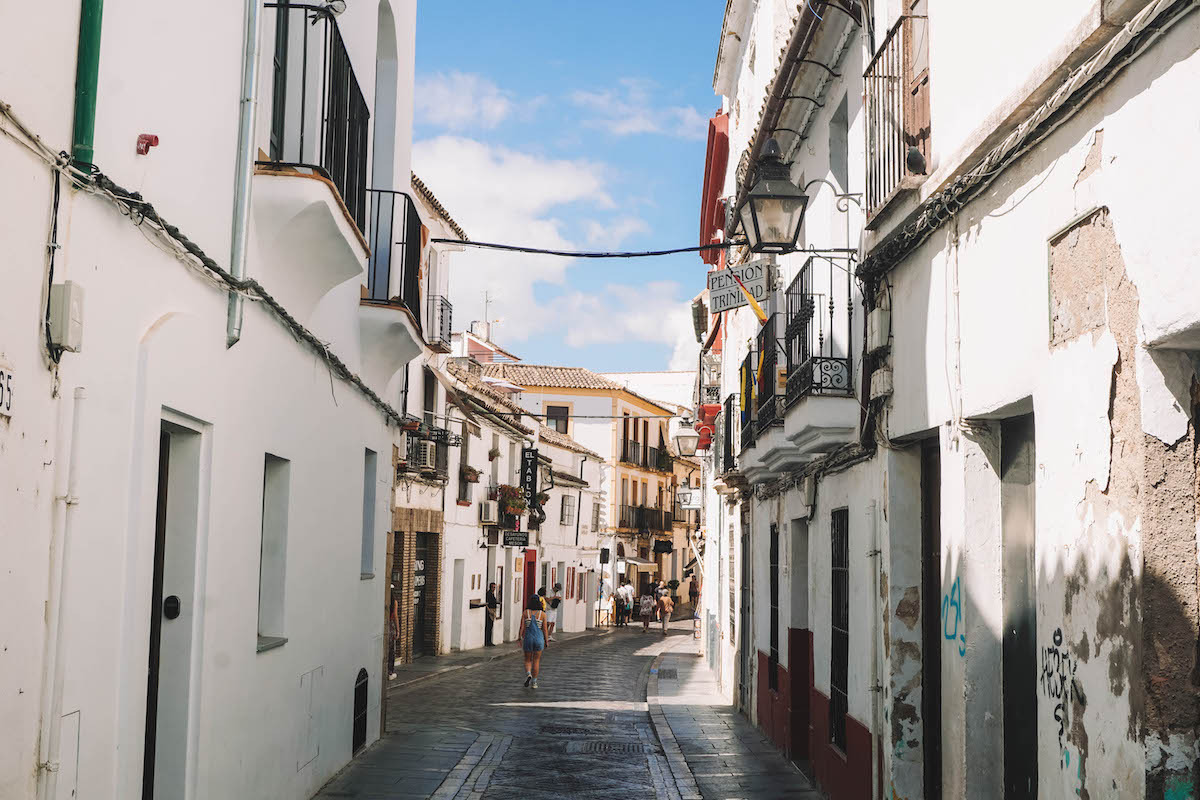
Below are the best things to do in Córdoba in one day or two days. If you have just one day in Córdoba, it will definitely be a full day BUT you can definitely see most of the city in that amount of time. However, I’ve also provided a suggested itinerary for two days in Córdoba in case you want to have a more relaxed visit like I did.
Things to Do in Córdoba, Spain in 1 Day
- Breakfast at Plaza de Corredera (I recommend churros at Mari Paz)
- Cathedral (remember that it’s free from 8:30 – 9:30am!)
- Flower Street
- Alcazar of the Catholic Monarchs
- Roman Bridge
- Palacio de Viana
- Aimlessly wander through the Old Town
Things to Do in Córdoba, Spain in 2 Days
Day 1:
- Mosque-Cathedral
- Flower Street
- Roman Bridge + Calahorra Tower, if desired
- Alcazar of the Catholic Monarchs
- Almodóvar Gate
Day 2:
- Palacio de Viana
- Templo Romano
- Plaza de las Tendillas
- Plaza de Corredera at night
If you have more time, you can also sign up for a walking tour, buy produce at the market at Plaza de la Corredera, explore the Old Town on foot, and so on.
What’s the Best Area to Stay in Córdoba, Spain?
I stayed at Plaza de la Corredera in an AirBNB and loved the atmosphere! It’s definitely not a good place to stay if you need total silence to sleep, but the energy is infectious. The plaza has some fun nightlife but it’s very much family friendly.
What’s the Best Time to Visit Córdoba, Spain?
Córdoba gets HOT in the summertime, so I recommend visiting in shoulder season to avoid the worst of the heat and crowds (April / May or September / October). Or, visit at the beginning of May during the Patio Festival to see the colorful courtyards the city is known for!
Adiós, Córdoba!
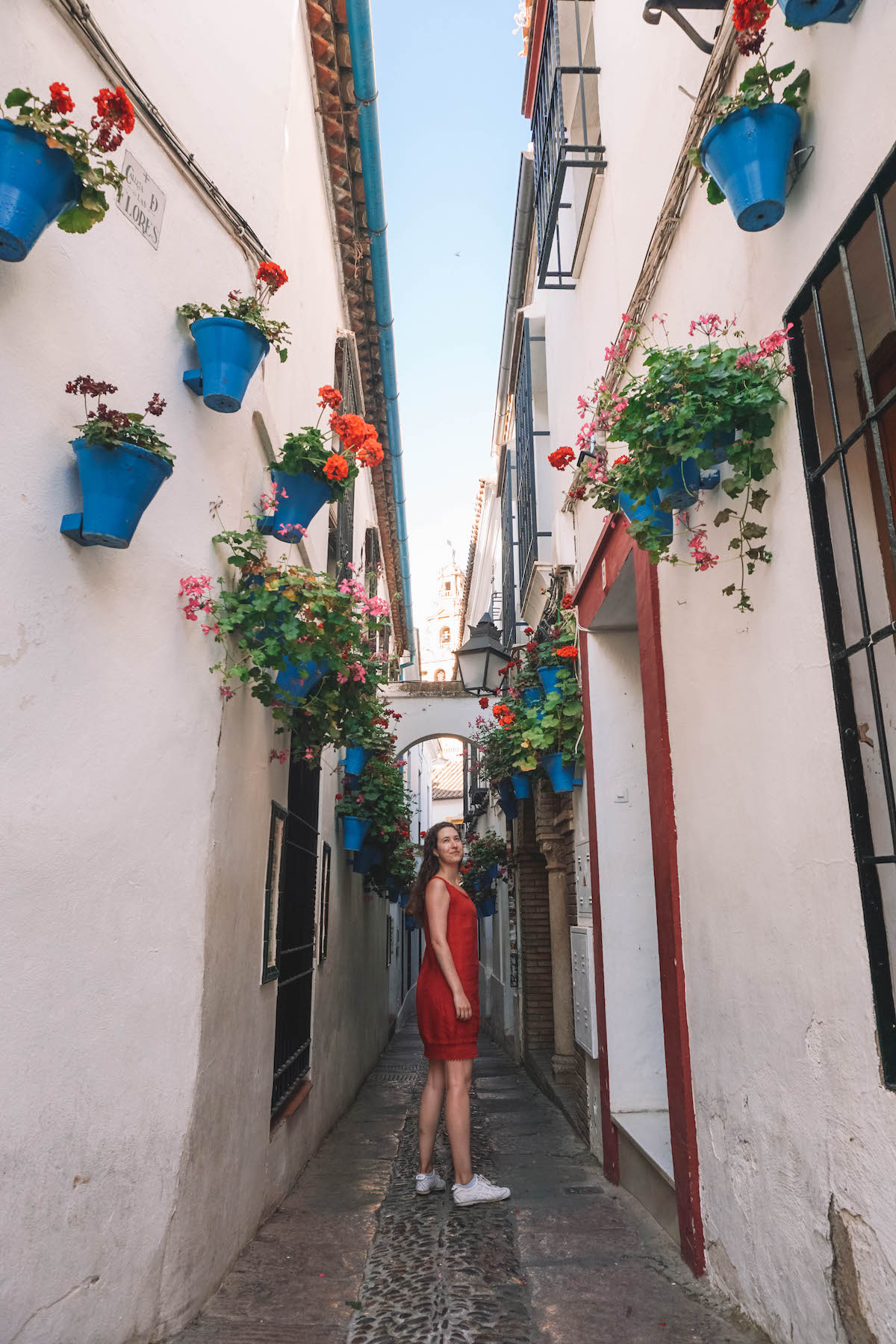
Now that you know the best things to do in Córdoba, Spain, it’s time to start planning your trip! I had a lovely two days in Córdoba and would absolutely return as a day trip from Seville or Malaga. The Mosque-Cathedral and Palacio de Viana are the two must-see attractions in Córdoba in my book, everything else was just icing on the cake!
If you have any questions about visiting Córdoba, leave me a comment below. And don’t forget to follow me on Instagram to keep up with my daily adventures in Berlin and beyond!

Leave A Reply!